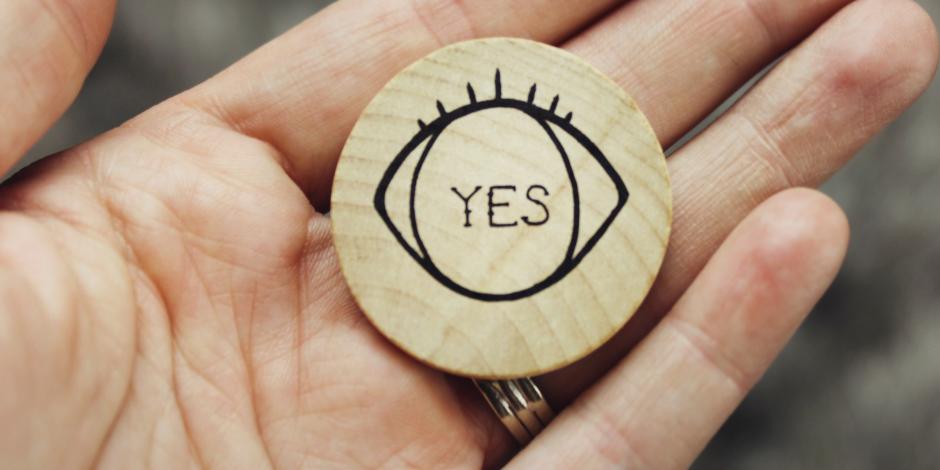Imagine a business meeting. Let’s assume you have an idea that is quite well thought out and, what’s more, you are prepared to suggest this idea to everyone in the meeting. What is the response likely to be?
There’s a standard reaction to ideas that are brought up in meetings or conversations. I’m sure you’ve heard it before. First, let me say what this reaction is not. It is not genuineechtgenuine excitement about a great idea, nor is it a sincereaufrichtigsincere thank you for your contribution. It’s not an inclusive question that asks what everybody else thinks. And it isn’t an offer to to expand on sth.auf etw. näher eingehenexpand on your idea either.
Instead, the most common response to an idea is: “Yes, but...” It might be “Yes, but have you considered the costs?” or “Yes, but we don’t have the resourceshier: (Finanz-)Mittelresources for that right now” or “Yes, but... [to insert sth.etw. einfügeninsert objectionEinwandobjection here]”.
A three-letter word
This is not to say that objections may not be valid — perhaps the costs really would be too high or resources aren’t available. People should be able to express their concerns freely, and yet, that one word at the beginning — B-U-T — can make the sentence toxic. Those three letters have the power to to crush sth.etw. zerquetschen; hier: im Ansatz vernichtencrush the tiny seedSamen, Keimseed of an idea.
Let’s say you suggest to your best friend that the two of you go to the open-air cinema tonight, and she responds with: “Yeah, but what if it rains?” Does that to spark sth.etw. auslösenspark joy and motivate you to convince her to go out? Does it make you look forward to a great evening? Or are you more likely to forget the idea and watch Netflix on the couch (again)?
When I explain the “Yes, but...” effect in team workshops, people are sometimes sceptical and look puzzledverwirrtpuzzled. They may even to dismiss sth.etw. abtundismiss the whole idea: “If I have concerns, what else can I say except ‘but’?” In such cases, there’s an activity that can demonstrate the “Yes, but...” effect.
Put sceptics in pairs. Let’s call our pair Alice and Ben. In each round, one of them makes a suggestion. Examples could be: “Let’s have a party” or “Let’s have an offsiteZusammenkunft außerhalb der gewohnten Arbeitsumgebungoffsite”. Play three rounds.
People can often sense the word ‘but’ before it’s actually spoken
Round 1: the “No” round
In the first round, Alice begins with “Let’s do...”. Ben has the easiest job in the world — all he needs to do is say no to everything. No explanation is needed. So, Alice has to come up with alternative ideas but, every time, Ben’s answer is no. Let this continue for two or three minutes, then have them switch roles.
When asked how they felt during this exercise, people give answers from both ends of the spectrum. Some describe it as frustrating and demotivating to hear no all the time, while others enjoy coming up with new and better ideas each time. And still others say it was a relief (even a pleasure) to be able to say no.
If people are aware of how they feel and how they react to this first part of the exercise, they (and you) will learn a lot about their inner motivation and how they react to stress. If you’re working together, it’s very helpful to know this about your colleagues.
You can, of course, ask for a quick summaryZusammenfassungsummary of everyone’s experience of saying and hearing no all the time — or (as I prefer to do) have more detailed feedback at the end.
Round 2: the “Yes, but...” round
Note: Make sure you move quickly from one round to the next. If you notice that some couples are distractedabgelenktdistracted or chatting, move on to the next round. Keep it dynamic. Again, Alice starts by making suggestions. Now, however, Ben’s task is to find a more or less reasonable argument against it, saying “Yes, but...” — for example “Yes, but we have so much work to do”. Now, choose one of these two options:
Option A: Ben keeps going as described above. Alice has to come up with new ideas. After a while, they change roles.
This may not seem different from the previousvorausgegangenprevious round, but in this case, the sentence starts with “Yes” — to suggest sth.etw. suggerieren, vermuten lassensuggesting that my partner has listened carefully and agrees, in principle, with what I’ve said. Then, this feeling of cooperation is destroyed by the word “but”.
If you don’t think the word is powerful, consider that people can often sense the word “but” before it’s actually spoken. Think about this example: “I think you are doing a great job, BUT in your presentation yesterday, you looked quite insecureunsicherinsecure.” Do you think anyone will remember, or care about, the first part of that sentence? Everything before the “but” becomes meaningless.
Option B: Ben starts with “Yes, but...” and states his argument. Then, it’s his turn to make an alternative suggestion, and Alice will respond with “Yes, but...” and so on. In this case, they change roles each time.
Compared to option A, this evenlygleichmäßigevenly distributes the responsibility for coming up with ideas, and everyone experiences being “to be yes-butted (ifml.)die Antwort „ja, aber“ erhaltenyes-butted”. Here, too, when asked how they felt about this round, people give a variety of responses.
Everything before the ‘but’ becomes meaningless
Round 3: the “Yes,... and...” round
If you think this round is going to work better, you’re right. Alice makes her suggestion for something they could do as a team. Now, Ben responds with “Yes,... and...”. He to paraphrase sth.etw. umformulierenparaphrases what Alice says (“Yes, let’s have a team offsite AND...”) and then expands on the idea (“...let’s do it somewhere where we can spend some time outdoors” or “let’s make sure everyone can join in”).
You might be wondering if I expect you to agree with every suggestion one of your colleagues comes up with. I would only say that it’s helpful to show others that you’re really listening and taking their inputBeitraginput seriously. This is to reinforce sth.etw. verstärkenreinforced by paraphrasing what you have just heard. Look at these two examples:
The “Yes, but...” version:
“We should have a team offsite.”
“Yes, but who’s going to do all our work while we’re there?”
The “Yes,... and...” version:
“We should have a team offsite.”
“Yes, let’s consider having a team offsite and see how we can make it fit everyone’s scheduleTerminplanschedule.”
The second example doesn’t necessarily mean the offsite is really going to happen. Perhaps, ultimatelyletztendlichultimately, it won’t be practical. Starting with “Yes,... and...” means you’re thinking together and not against each other, building upon other people’s ideas, and that’s the basis for working together in a team.
I recommend doing this little exercise with your team. It takes only 15 minutes. And practising this together will help improve cooperation in your team and beyond. Maybe the most common beginning to a sentence will change to “Yes,... and...”.
ESSENTIAL PHRASES
MAKING SUGGESTIONS
There are various expressions you can use to make suggestions. Many language learners make the mistake of using the infinitive with all these phrases, but a closer look shows that some of them are followed by a gerund.
Followed by an infinitive
• I think we should organize a meeting so we can discuss the changes.
• Why don’t we have an offsiteZusammenkunft außerhalb der gewohnten Arbeitsumgebungoffsite with everyone?
• Perhaps we ought to start a webinar series.
• My first suggestion is to look at your target groupZielgruppetarget group closely, to get a better idea.
Followed by a gerund
• How about running some A/B testVergleichstest zweier VersionenA/B tests?
• I’d recommend to postpone sth.etw. verschiebenpostponing the launchMarkteinführunglaunch until spring.
• Paul suggested going to the Indian restaurant for lunch.
• Have you thought about to pitch sth.etw. präsentieren, vorstellenpitching the idea to the boardVorstand, Geschäftsführungboard?
Now, try this!
The verb “try” can be followed by either an infinitive or a gerund, but the meaning is slightly different. Look at these two examples:
• Why don’t we try to increase sales in the next quarterQuartalquarter? (= We don’t know if it’s possible, but we’re going to try.)
• Why don’t we try lowering the price to increase sales? (= We can do this, but we don’t know if it will have the desired effect.)
FRANK PETERS lives in Cologne and works as a coach with teams and leaders, to make them a successful and happy team (again)
Neugierig auf mehr?
Dann nutzen Sie die Möglichkeit und stellen Sie sich Ihr optimales Abo ganz nach Ihren Wünschen zusammen.



